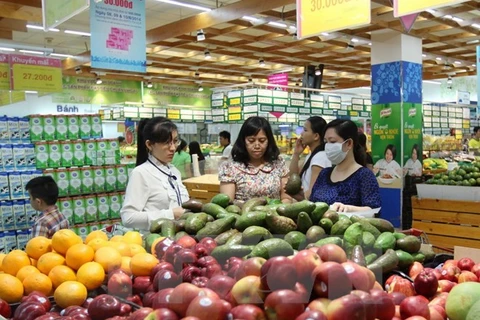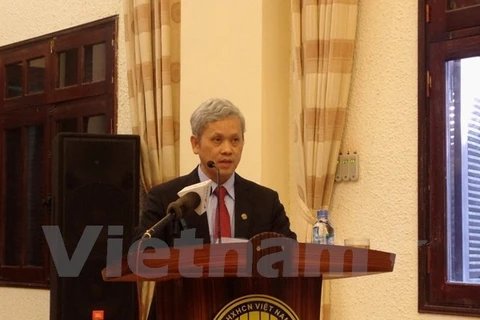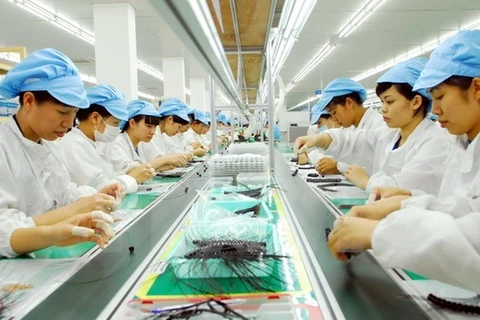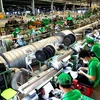Hanoi (VNA) — The Department of Price Management will seek to improve market analysis and forecast in order to implement appropriate policies and control inflation at 4 percent, as set by the National Assembly for 2017, Deputy Minister of Finance Tran Van Hieu said.
At a conference at the end of December, 2016, the Deputy Minister asked the price watchdog to tighten price management to prevent dramatic price hikes ahead of the Tet (Lunar New Year) holiday, especially in areas recently hit by natural disasters.
Although the macro-economy is expected to remain stable in 2017, potential exists for a rise in inflation, the department said. For example, the adjustment of health care and education fees in late 2016 and in 2017 is expected to create inflationary pressure.
The department said that power and fuel costs would also be under pressure, coupled with unfavourable weather conditions which would affect the supply of goods and services, especially food and food stuffs.
The price adjustments of products and services, which have significant effects on the economy, would be evaluated carefully to minimise their impacts and focus would be placed on market data collection and analysis, the department said.
Inflation under control
Nguyen Thi Thuy Nga, the department’s Deputy Director, said the department implemented flexible price management policies in coordination with other ministries to control inflation in 2016 at below 5 percent as set by the National Assembly. The inflation rate had in fact been kept relatively low at 4.74 percent in 2016.
This was due to the combined effort of the Government and financial economic administrative agencies, according to Nguyen Bich Lam, director general of the General Statistics Office (GSO).
Annual core inflation increased 1.83 per cent compared with 2015.
The rise in core inflation from January to December 2016 compared with the same period in 2015 showed narrow amplitude, fluctuating from 1.64 to 1.88 percent, a result of a steady monetary policy being put into practice, helping the country’s macroeconomic stability and keeping inflation under control.
The year 2017 will see a change in the inflation calculation method by using the average annual CPI instead of the change in CPI between December of the current year and the previous one, Le Thi Minh Thuy, director of the GSO’s Trade and Service Statistics Department, said.
Lam also expressed the GSO’s concern through a petition to the Government proposing several solutions to keep inflation under control in 2017, with the target of a four percent CPI rise as indicated by the National Assembly.
As such, price adjustment methods must be employed for health care services, electricity, water and interest rates, and a close watch must be kept on global oil prices to prevent the domestic price from shooting up and affecting the 2017 CPI. — VNA
At a conference at the end of December, 2016, the Deputy Minister asked the price watchdog to tighten price management to prevent dramatic price hikes ahead of the Tet (Lunar New Year) holiday, especially in areas recently hit by natural disasters.
Although the macro-economy is expected to remain stable in 2017, potential exists for a rise in inflation, the department said. For example, the adjustment of health care and education fees in late 2016 and in 2017 is expected to create inflationary pressure.
The department said that power and fuel costs would also be under pressure, coupled with unfavourable weather conditions which would affect the supply of goods and services, especially food and food stuffs.
The price adjustments of products and services, which have significant effects on the economy, would be evaluated carefully to minimise their impacts and focus would be placed on market data collection and analysis, the department said.
Inflation under control
Nguyen Thi Thuy Nga, the department’s Deputy Director, said the department implemented flexible price management policies in coordination with other ministries to control inflation in 2016 at below 5 percent as set by the National Assembly. The inflation rate had in fact been kept relatively low at 4.74 percent in 2016.
This was due to the combined effort of the Government and financial economic administrative agencies, according to Nguyen Bich Lam, director general of the General Statistics Office (GSO).
Annual core inflation increased 1.83 per cent compared with 2015.
The rise in core inflation from January to December 2016 compared with the same period in 2015 showed narrow amplitude, fluctuating from 1.64 to 1.88 percent, a result of a steady monetary policy being put into practice, helping the country’s macroeconomic stability and keeping inflation under control.
The year 2017 will see a change in the inflation calculation method by using the average annual CPI instead of the change in CPI between December of the current year and the previous one, Le Thi Minh Thuy, director of the GSO’s Trade and Service Statistics Department, said.
Lam also expressed the GSO’s concern through a petition to the Government proposing several solutions to keep inflation under control in 2017, with the target of a four percent CPI rise as indicated by the National Assembly.
As such, price adjustment methods must be employed for health care services, electricity, water and interest rates, and a close watch must be kept on global oil prices to prevent the domestic price from shooting up and affecting the 2017 CPI. — VNA
VNA
























